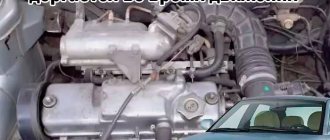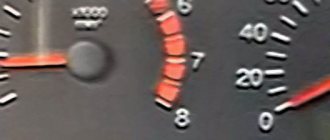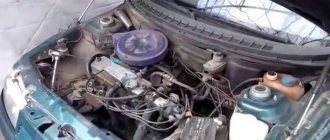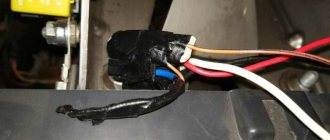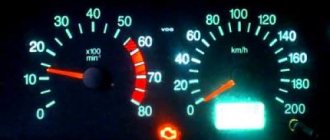Why does the car jerk?
There can be simply a huge number of problems due to which a car can drive jerkily (twitch), and they are individual for each car. These could be problems with the fuel system or transmission problems. Let's look at each of the reasons.
Fuel problems
Problems related to fuel supply to the engine.
Gasoline pump
All cars with injection engines are equipped with a fuel pump that pumps pressure into the fuel system. The normal operating pressure of the pump reaches 10 kg/cm³. Over time, the pump may lose its former power due to aging or dirty filters, fine and coarse fuel cleaning, which will undoubtedly lead to a loss of pressure and improper operation of the internal combustion engine.
Injectors
Another important indicator in the fuel system is the injectors. They spray fuel into the engine cylinder head, mixing it with air and feeding it into the combustion chamber. Over time, the injector nozzle becomes clogged with dirt and carbon deposits, which contributes to incorrect and even insufficient fuel atomization, which leads to uneven operation of the entire internal combustion engine.
Ignition problems
Problems associated with the formation of a spark in the engine.
Candles
To ignite the fuel mixture in a car, spark plugs are used, which produce sparks in the combustion chamber, thereby igniting the air-fuel mixture. Over time, due to the low quality of fuel, which is abundant in the vast expanses of the Russian Federation, spark plugs become covered with soot or, due to exposure to high temperatures, change their gap, which leads to improper operation of the internal combustion engine.
Wires
Spark plug wires also play an important role in engine operation; they transmit high voltage from the coil to the spark plug. The insulation of these wires is made of silicone and, under the influence of high temperatures and time, is subject to drying out and, consequently, cracks. High voltage, passing through a wire with a crack, can make its way to the body and thus does not even reach the spark plug, this is especially noticeable at high speeds and when the car is running under load.
Reels
The ignition module is the element that produces a spark to the cylinders; when it fails, the cylinders fail, but it often happens that the module can turn off due to temperature or load. By the way, the ignition module is no longer available in more modern cars; it was replaced by individual ignition coils, which helped get rid of wires and their problems. The IKZ is put directly on the spark plug and produces a spark for exactly one cylinder in which it is installed.
Transmission problems
Problems related to the gearbox, drives and wheels.
checkpoint
The gearbox is responsible for moving the car. Breakdowns are possible very often, especially if it is a rather complex automatic transmission, in which you have to frequently change the oil and monitor its quality. Failures in the gearbox can be in bearings, shafts, or clutches.
Drive
Car drives or cardans, which transmit rotation from the gearbox to the wheels, can also be the reason why the car jerks. Wear of constant velocity joints can create backlash between the gearbox and the wheel, which will lead to jerking. It’s the same with the cardan transmission, whether it’s on a crosspiece or a CV joint, its wear promises knocks and jerks.
Wheels
Wheels that have uneven wear, namely ellipse, can create jerks on the car when it moves at a certain speed, this is most noticeable on a flat road at a speed of 40 km/h.
Cleaning the injector.
First, of course, you should check the spark plugs, however, if the car starts normally and jerks when driving hot, the problem is most likely not in them, but in the injection system. First, let's look at the stages of clogging of the mechanism, there are three in total:
- At this stage you will not notice any changes. When hot, the car runs perfectly, does not jerk and there seems to be no problems with the engine, which so far starts normally. Typically, this stage almost always progresses into the next one.
- While the car still does not jerk when driving, but the engine is not very stable when hot, small adjustments are possible; gasoline consumption also increases, the car sneezes when it starts.
- The last stage, it is no longer possible not to notice it. The car jerks noticeably when driving, warming up does not help, and the engine also runs disgustingly when hot. If you don't take care of the injector at this stage. Very soon, your car's engine will require more serious and expensive repairs.
Methods for flushing the injector
If you are not a professional auto mechanic, you should not even think about flushing the injector yourself. Otherwise, the car will not only stop jerking when hot, but will not start or drive at all.
However, one way or another, theoretical knowledge in the field of cleaning the injection mechanism will still not hurt. Having familiarized yourself with the theory and seen in practice how masters do this procedure, next time you will cope with it yourself.
Liquid flushing
So, first on the list is liquid cleaning of the injection mechanism. In this case, the car starts, however, the fuel supply is disconnected. Instead of a fuel supply hose, a special flushing system is connected to the engine, which supplies fluid to the injectors. The washing procedure in this case is carried out, as they say, hot.
It is important that in this case the washing does not get into the gas tank, otherwise it will dissolve deposits on the machines. As a result, the fuel filter and pump will become clogged and will need to be replaced.
As for the choice of fluid, it all depends on the age of the car and the degree of contamination of the injection mechanism. The ideal option is to entrust the choice of washing to professionals. Those who are faced with cleaning the injector every day will be able to choose exactly the composition that will not harm the engine. In general, ideally, maintenance in the form of such a liquid flush is recommended for all relatively new cars every 30 thousand kilometers.
Ultrasonic cleaning
A more powerful alternative to liquid is ultrasonic engine flushing. In this case, the nozzles are dismantled and placed in an ultrasonic device. Next, all that remains is to set the required washing time, everything else will happen automatically. The device itself for ultrasonic cleaning of the injector is quite expensive, and you can only find it in a good service. The main thing is that the washing in this case is carried out by a professional. If you choose the wrong time, the injector will be damaged and the car will not only stop jerking when hot, but also stop starting.
What to choose
There shouldn’t be any problems with choosing when it comes to cleaning the injector. It all depends solely on the age and general condition of the car. If there are no serious problems - the car does not jerk, starts well, and the engine runs stably when hot, choose flushing with liquid chemicals. You can deal with the first and second stages of contamination in this way without any problems.
If the car jerks, then it’s time to resort to heavy artillery in the form of ultrasonic washing. However, first it is necessary to carry out qualified diagnostics of the car and exclude other causes of unstable engine operation when hot.
For example, spark plugs or idle speed sensor. In approximately 90% of cases, the problem, as it turns out, is precisely these spare parts, and flushing the injector is not necessary at all. How to perform diagnostics is described in detail above.
The car jerks due to faults in the manual transmission
For normal movement of a car with a manual transmission, constant gear shifting is required. The main rule of manual cars is to switch the lever on the box in time and correctly. If you violate the sequence, you can quickly wear out the parts and simply bring the car in for repairs.
In the case of a manual transmission, when changing gears, the car jerks due to the actions of the driver. What should you not do if you are still driving a manual car? First of all, it is necessary to choose the right time to press the clutch pedal and change gears. Do not delay the transition to high gears, and after switching to it, avoid sharp pressure on the gas pedal. The most important thing is that there is no need to press the pedals randomly at speed; every action should be thought through or you will cause damage to your car.
Impact of jerks on the car
Whether jerking the car is beneficial or harmful is a rhetorical question. It’s the same as poking a person with a knife and asking if your health is improving. Any kind of jerking of the car is harmful, be it just a jolt when driving or a consequence of changing gears.
The main impact falls on the transmission unit and the engine part. First of all, the load on moving elements (bearings, switches, gears) increases. Each impact can deform, leave a crack or completely break any of these elements. Repairs can take a long time and cost the car owner a significant amount of money. That is why it is important to initially determine the reason why the car began to twitch and eradicate it.
What's the result?
As you can see, at the initial stage of diagnosis, if the engine twitches at idle, you should start with the simplest:
- check spark plugs and high-voltage wires;
- assess the condition of the air and fuel filter;
- if the car has a carburetor, clean and adjust the carburetor;
- on the injector, check and wash the nozzles;
- perform computer diagnostics of the engine;
If the diesel engine jerks at idle, then problems with the injection pump should also be added to the general list of possible problems. The pump has many moving elements, damage to which or clogging can also lead to jerking or obvious tripping in the cylinders.
Why might the engine vibrate at idle? Causes of malfunction, diagnostics. Tips and recommendations for reducing engine vibration levels.
Why does the car engine shake during warm-up, and how to fix it?
Warming up the vehicle. This topic is as old as the World. Go to any car forum, and you will see that there are a lot of people writing about how their car behaves strangely while warming up. This article will also talk about warming up the engine, or more precisely about why it shakes for the first minute after turning on the ignition.
Every person who knows at least a little about cars knows that on a fully functional engine, the tachometer needle should lie at the lowest extreme point and not move. At the same time, the power unit should not make any extraneous sounds. But it happens that during normal warm-up the engine jerks. This lasts from 30 seconds to one minute.
It would seem that it won’t last long, and therefore there is no need to worry. But in reality, this causes tension for the owner of the vehicle. As practice shows, owners of cars produced by the Volkswagen concern face this problem more often than others.

